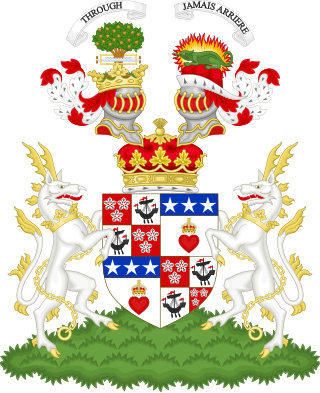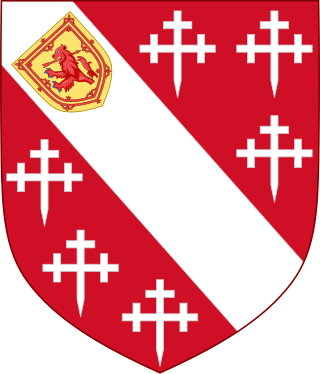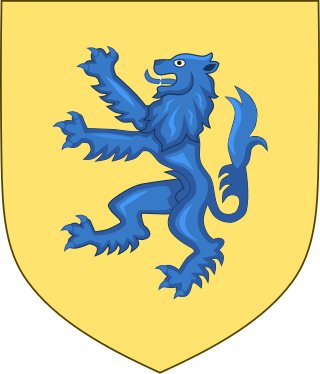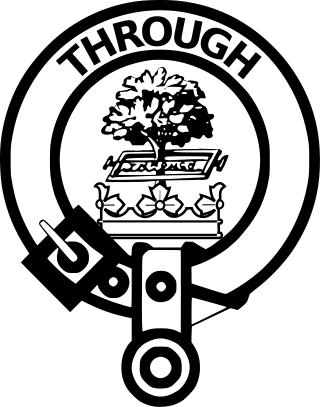| | | | | | | | | | | | James II
1430–1460
King of Scotland | |
|
| | | | | | | | | | | | | | | | |
| | | | | | | | | |
| Earl of Arran (Scotland) (1st creation), 1467 | | | | | | | Lord Hamilton, 1445 | | | | | |
|
Thomas Boyd
d. c. 1473
Earl of Arran | | Mary Stewart
1453–1488
dowager Countess of Arran | | James Hamilton
c. 1415–1479
1st Lord Hamilton | | James III
1451–1488
King of Scotland | |
| | |
| Earldom of Arran (1st creation) forfeit, 1469 | | | | | | | | | | | | | | | |
| | | |
| | | | Earl of Arran (Scotland) (2nd creation), 1503 | | | | | | | | | |
|
| | | | James Hamilton
c. 1475–1529
2nd Lord Hamilton, 1st Earl of Arran | | | | | | James IV
1473–1513
King of Scotland | |
|
| | | | | | | | | | | | | | | | |
|
| | | | | | | | | | | | | Catherine Stewart (illegit.)
c. 1495–1554 | | James Douglas
d. 1548
Earl of Morton |
| |
| | | | Duke of Châtellerault (France) (5th creation), 1548 | | | | | | | | | | | | |
| | | |
| | | | James Hamilton
c. 1516–1575
2nd Earl of Arran, 3rd Lord Hamilton, 1st Duke of Châtellerault | | | | | | Margaret Douglas
c. 1510–1579 | |
| | | | | |
| | | | Dukedom of Châtellerault (5th creation) forfeit, 1559 | | | | | | | | | | | | | | | | | | | | | |
|
| | | | | | | | | | | | | | | | | | | | | | | | | |
| | | | | | | | | | | | | | | | | | | | | | | |
| | | | | | | | | | Marquess of Hamilton, Earl of Arran, and Lord Aven, 1599 | | | | | | | | | | Lord Paisley, 1587 |
|
James Hamilton
c. 1533–1609
3rd Earl of Arran, 4th Lord Hamilton | | Anne Hamilton
c. 1535 – c. 1574
m. George Gordon Earl of Huntly | | John Hamilton
1540–1604
1st Marquess of Hamilton | | | | | | | | | | Claud Hamilton
1546–1621
1st Lord Paisley |
|
| | | | | | | | | | | | | | | | | | | | | | | | | |
|
| | | | | | | | | Earl of Cambridge (England) (4th creation) and Baron of Innerdale, 1619 | | | | | | | | | | Lord Abercorn, 1603
Earl of Abercorn, 1606 |
|
| Earls of Angus | | George Gordon
1562–1636
Marquess of Huntly | | James Hamilton
1589–1625
2nd Marquess of Hamilton, 4th Earl of Arran, 1st Earl of Cambridge and Baron of Innerdale, 5th Lord Hamilton, Lord Aberbrothwick/Arbroath | | | | | | | | | | James Hamilton
1575–1618
1st Earl of Abercorn and Lord Abercorn |
|
| | | | | | | | | | | | | | | | | | | | | | | | | | | | | | | | | | | | | | | | | |
| | | | | | | | | | | | | | | | | | | | | | | |
| | | | | | | | | | Duke of Hamilton, Marquess of Clydesdale, Earl of Arran and Cambridge (Scotland) and Baron of Aven and Innerdale, 1643 | | Earl of Lanark, 1639 | | Baron Hamilton of Strabane, 1617 | | | | | | | | | | | | | | | | | | |
|
William Douglas
1589–1660
Marquess of Douglas, Earl of Angus, Lord Abernethy, Lord Bonkyll and Preston, Lord Jedburgh Forest | | Mary Gordon
c. 1600–1674 | | James Hamilton
1606–1649
1st Duke of Hamilton, Marquess of Clydesdale, Earl of Arran and Cambridge, and Lord Aven and Innerdale, 3rd Marquess of Hamilton, 5th Earl of Arran, 2nd Earl of Cambridge and Baron of Innerdale | | William Hamilton
1616–1651
2nd Duke of Hamilton, Marquess of Clydesdale, Earl of Arran and Cambridge, and Lord Aven and Innerdale, 1st Earl of Lanark, 6th Earl of Arran, 3rd Earl of Cambridge and Baron of Innerdale | | James Hamilton
c. 1604 – c. 1670
2nd Earl of Abercorn and Lord Abercorn, 2nd Lord Paisley, 1st Lord Hamilton of Strabane | | | | | | Claud Hamilton
c. 1606–1638
2nd Lord Hamilton of Strabane | | | | | | George Hamilton
c. 1607–1679 |
| |
| | | | | | | | | | | | | | | | Earldom of Cambridge (4th creation) and Barony of Innerdale extinct and Earldom of Arran (2nd creation) dormant, 1651 | | | | | | | | | | | | | | | | | | | | | | | | | |
| | | | | | | | | | | | | | | |
| | | | | Earl of Selkirk and Lord Daer and Shortcleuch, 1646 | | | | | | | | | | | | | | | | | | | | | | | | | | | | | | | | | | |
|
| see Earl of Ormond family tree for Earls of Angus, etc. | | William Douglas (Hamilton)
1634–1694
suo uxoris Duke of Hamilton, Marquess of Clydesdale, Earl of Arran and Cambridge, and Lord Aven and Innerdale,
suo jure 1st Earl of Selkirk and Lord Daer and Shortcleuch | | Anne Hamilton
1631–1716
suo jure 3rd Duchess of Hamilton, Marchioness of Clydesdale, Countess of Arran and Cambridge, and Lady Aven and Innerdale, 2nd Countess of Lanark | | | | | | George Hamilton
c. 1636 – c. 1680
3rd Earl of Abercorn and Lord Abercorn | | James Hamilton
c. 1633 – c. 1670
Lord Paisley | | James Hamilton
1633–1655
3rd Lord Hamilton of Strabane | | George Hamilton
c. 1636–1668
4th Lord Hamilton of Strabane | | James Hamilton
c. 1620–1673 |
| |
| | | | | | | | | Ceded Dukedom of Hamilton to 4th Duke, 1698 | | | | | | | | | | | | | | | | | | | | | | | | | | | | |
| | | | | |
| | | | | | | | | | | | | | | | | | | | | | | | | | | | | | | | | | | | | | | | | |
| | | | | | | | | | | | | | | | | | | | |
| Duke of Brandon and Baron Dutton, 1711 | | | | | | | Earl of Ruglen, 1697 | | Earl of Orkney (3rd creation), 1697 | | | | | | | | | | | | | | | | | | | | | | Viscount Strabane and Baron Mountcastle, 1701 |
|
James Hamilton
1658–1712
4th Duke of Hamilton, Marquess of Clydesdale, Earl of Arran and Cambridge, and Lord Aven and Innerdale, 1st Duke of Brandon and Baron Dutton, 3rd Earl of Lanark and Lord Machansyre and Polmont | | Charles Douglas
1663–1739
2nd Earl of Selkirk and Lord Daer and Shortcleuch | | John Douglas-Hamilton
1664–1744
3rd Earl of Selkirk and Lord Daer and Shortcleuch, 1st Earl of Ruglen | | George Hamilton
1666–1737
1st Earl of Orkney | | Basil Hamilton
1671–1701 | | Catherine Hamilton | | Charles Hamilton
d. 1701
5th Earl of Abercorn and Lord Abercorn, 6th Lord Hamilton of Strabane | | Claud Hamilton
1658–1691
4th Earl of Abercorn and Lord Abercorn, 5th Lord Hamilton of Strabane | | James Hamilton
c. 1661–1734
6th Earl of Abercorn and Lord Abercorn, 7th Lord Hamilton of Strabane |
|
| | | | | | | | | | | | | | | | | | | | | | | | | | | | | | | | | | | | | | | | |
| | | | | |
| | | | | | | | | Earls of Ruglen | | Earls of Orkney | | Basil Hamilton
1696–1742 | | | | | | | | | | James Hamilton
1685–1744
7th Earl of Abercorn and Lord Abercorn, 8th Lord Hamilton of Strabane |
|
| | | | | | | | | | | | | | | | | | | | | | | | | | | | | | | | | | | |
| | | | | | | | | | | | | | | | | | |
| | | | | | | | | | | | | | | | | | | | | | | | | | | Viscount Hamilton, 1786 | | | | | |
|
James Hamilton
1703–1743
5th Duke of Hamilton, Marquess of Clydesdale, Earl of Arran and Cambridge, and Lord Aven and Innerdale, 2nd Duke of Brandon and Baron Dutton, 4th Earl of Lanark and Lord Machansyre and Polmont | | | | | | | | | | Lord Anne Hamilton
1709–1748 | | Dunbar Douglas
1722–1799
4th Earl of Selkirk and Lord Daer and Shortcleuch | | | | | | James Hamilton
1712–1789
8th Earl of Abercorn and Lord Abercorn, 9th Lord Hamilton of Strabane | | John Hamilton
1714–1755 |
|
| | | | | | | | | | | | | | | | | | | | | | | | | | | | | | | | | | | |
| | | | | | | | |
| | | | | Baron Hamilton of Hameldon county, Leicester, 1776 | | | | | | | | | | | | | | | | | | | | | | | | | Marquess of Abercorn, 1790 |
|
James Hamilton
1724–1758
6th Duke of Hamilton, Marquess of Clydesdale, Earl of Arran and Cambridge, and Lord Aven and Innerdale, 3rd Duke of Brandon and Baron Dutton, 5th Earl of Lanark and Lord Machansyre and Polmont | | Elizabeth Gunning
(c. 1733–1790)
suo jure 1st Baroness Hamilton | | Archibald Hamilton
1740–1819
9th Duke of Hamilton, Marquess of Clydesdale, Earl of Arran and Cambridge, and Lord Aven and Innerdale, 6th Duke of Brandon, Marquess of Douglas, Earl of Angus, and Lord Abernethy and Jedburgh Forest, 8th Earl of Lanark and Lord Machansyre and Polmont | | Charles Powell Hamilton
1747–1825 | | | | | | | | | | | | | | | John Hamilton
1756–1818
9th Earl of Abercorn and Lord Abercorn, 1st Marquess of Abercorn, 10th Lord Hamilton of Strabane |
| |
| | | | | | | | | | | | | | | | | | | | | | | | | | | | | | | | | | | | | |
| | | | | |
James Hamilton
1755–1769
7th Duke of Hamilton, Marquess of Clydesdale, Earl of Arran and Cambridge, and Lord Aven and Innerdale, 4th Duke of Brandon and Baron Dutton, Marquess of Angus and Abernethy, Marquess of Douglas, Earl of Angus, and Lord Abernethy and Jedburgh Forest, 6th Earl of Lanark and Lord Machansyre and Polmont | | Douglas Hamilton
1756–1799
8th Duke of Hamilton, Marquess of Clydesdale, Earl of Arran and Cambridge, and Lord Aven and Innerdale, 5th Duke of Brandon, Marquess of Douglas, Earl of Angus, Lord Abernethy and Jedburgh Forest, and Baron Dutton, 7th Earl of Lanark and Lord Machansyre and Polmont, 2nd Baron Hamilton | | Alexander Hamilton
1767–1852
10th Duke of Hamilton, Marquess of Clydesdale, Earl of Arran and Cambridge, and Lord Aven and Innerdale, 7th Duke of Brandon, Marquess of Douglas, and Baron Dutton, Earl of Angus, and Lord Abernethy and Jedburgh Forest, 9th Earl of Lanark and Lord Machansyre and Polmont | | Augustus Barrington Price Anne Powell Douglas-Hamilton
1781–1849 | | Thomas Douglas
1771–1820
5th Earl of Selkirk and Lord Daer and Shortcleuch | | | | | | | | | | James Hamilton
1786–1818
Viscount Hamilton |
|
| | | | | | | | | | | | | | | | | | | | | | | | | | | | | | | | | | |
|
| | | | | | | | | | | | | | | | | | | | | | | | | | | | | | | Duke of Abercorn, of Strabane and Duke of Abercorn, 1868 |
|
| | | | | | | | William Alexander Anthony Archibald Hamilton
1811–1863
11th Duke of Hamilton, Marquess of Clydesdale, Earl of Arran and Cambridge, and Lord Aven and Innerdale, 8th Duke of Brandon, Marquess of Douglas, Earl of Angus, Lord Abernethy and Jedburgh Forest, and Baron Dutton10th Earl of Lanark and Lord Machansyre and Polmont | | Charles Douglas-Hamilton
1808–1873 | | Dunbar James Douglas
1809–1885
6th Earl of Selkirk and Lord Daer and Shortcleuch | | | | | | | | | | James Hamilton
1811–1885
2nd Marquess of Abercorn, 10th Earl of Abercorn and Lord Abercorn, 1st Duke of Abercorn, 11th Lord Hamilton of Strabane |
|
| | | | | | | | | | | | | | | | | | | | | | | | | | | | | | | | | | |
| | | | | |
| | | | Duke of Châtellerault (France) (5th creation), revived 1548 | | | | | | | | | | | | | | | | | | | | | | | | | | | |
|
| | | | William Alexander Louis Stephen Douglas-Hamilton
1845–1895
12th Duke of Hamilton, Marquess of Clydesdale, Earl of Arran and Cambridge, and Lord Aven and Innerdale, 9th Duke of Brandon, Marquess of Douglas, Earl of Angus, Lord Abernethy and Jedburgh Forest and Baron Dutton, 2nd Duke of Châtellerault, 8th Earl of Selkirk and Lord Daer and Shortcleuch, 11th Earl of Lanark and Lord Machansyre and Polmont | | Charles George Douglas-Hamilton
1847–1886
7th Earl of Selkirk and Lord Daer and Shortcleuch | | | | | | | | | | | | | | | | | | | James Hamilton
1838–1913
2nd Duke of Abercorn, 3rd Marquess of Abercorn, 11th Earl of Abercorn and Lord Abercorn, 12th Lord Hamilton of Strabane |
|
| | | | | | | | | | | | | | | | | | | | | | | | | | | | | | | | |
|
| | | | | | | | | | | | Alfred Douglas Douglas-Hamilton
1862–1940
13th Duke of Hamilton, Marquess of Clydesdale, Earl of Arran and Cambridge, and Lord Aven and Innerdale, 10th Duke of Brandon, Marquess of Douglas, Earl of Angus (1633 creation), Lord Abernethy and Jedburgh Forest, and Baron Dutton, 20th Earl of Angus (1389 creation), 9th Earl of Selkirk and Lord Daer and Shortcleuch, 12th Earl of Lanark and Lord Machansyre and Polmont | | | | | | | | | | | | | | James Albert Edward Hamilton
1869–1953
3rd Duke of Abercorn, 4th Marquess of Abercorn, 12th Earl of Abercorn and Lord Abercorn, 13th Lord Hamilton of Strabane |
|
| | | | | | | | | | | | | | | | | | | | | | | | | | | | | | | | | |
| | | | | | | | | | | | | |
| | | | | | | | | | | | Douglas Douglas-Hamilton
1903–1973
14th Duke of Hamilton, Marquess of Clydesdale, Earl of Arran and Cambridge, and Lord Aven and Innerdale, 11th Duke of Brandon, Marquess of Douglas, Earl of Angus (1633 creation), Lord Abernethy and Jedburgh Forest, and Baron Dutton, 21st Earl of Angus (1389 creation), 13rd Earl of Lanark and Lord Machansyre and Polmont | | George Nigel Douglas-Hamilton
1906–1994
10th Earl of Selkirk and Lord Daer and Shortcleuch, 10th Lord Daer and Shortcleuch | | | | | | Malcolm Douglas-Hamilton
1909–1964 | | James Edward Hamilton
1904–1979
4th Duke of Abercorn, 5th Marquess of Abercorn, 13th Earl of Abercorn and Lord Abercorn, 14th Lord Hamilton of Strabane |
|
| | | | | | | | | | | | | | | | | | | | | | | | | | | | | | | | | | |
| | | | |
| | | | | | | | | | | | | | | | | Baron Selkirk of Douglas, 1997 | | | | | | | | | | | | | | |
|
| | | | | | | | | | | | Angus Douglas-Hamilton
1938–2010
15th Duke of Hamilton, Marquess of Clydesdale, Earl of Arran and Cambridge, and Lord Aven and Innerdale, 12th Duke of Brandon, Marquess of Douglas, Earl of Angus (1633 creation), Lord Abernethy and Jedburgh Forest, and Baron Dutton, 22nd Earl of Angus (1389 creation), 14th Earl of Lanark and Lord Machansyre and Polmont | | James Alexander Douglas-Hamilton
1942–2023
11th Earl of Selkirk and Lord Daer and Shortcleuch, Earldom disclaimed, 1994, Baron Selkirk of Douglas | | | | | | Alasdair Douglas-Hamilton
b. 1939 | | James Hamilton
b. 1934
5th Duke of Abercorn, 6th Marquess of Abercorn, 14th Earl of Abercorn and Lord Abercorn, 15th Lord Hamilton of Strabane |
|
| | | | | | | | | | | | | | | | | Barony Selkirk of Douglas expired as a life peerage, 2023 | | | | | | | | | | | | | | |
|
| | | | | | | | | | | | | | | | | | | | | | | | | | | | | | | | | | | | |
| | | | | | | | | | |
| | | | | | | | Alexander Douglas-Hamilton
b. 1978
16th Duke of Hamilton, Marquess of Clydesdale, Earl of Arran and Cambridge, and Lord Aven and Innerdale, 13th Duke of Brandon, Marquess of Douglas, Earl of Angus (1633 creation), Lord Abernethy and Jedburgh Forest, and Baron Dutton, 23rd Earl of Angus (1389 creation), 15th Earl of Lanark and Lord Machanshyre and Polmont | | John William Douglas-Hamilton
b. 1979 | | John Andrew Douglas-Hamilton
b. 1978
12th Earl of Selkirk and Lord Daer and Shortcleuch | | Charles Douglas Douglas-Hamilton (b. 1979) | | Angus Gavin Douglas-Hamilton
b. 1968 | | James Hamilton
b. 1969
styled Marquess of Hamilton |
|
| | | | | | | | | | | | | | | | | | | | | | | Heir presumptive to the Earldom of Selkirk | | | | | | | | | | |
| | | | | | | | | | |
| | | | Douglas Douglas-Hamilton
b. 2012
styled Marquess of Douglas and Clydesdale | | William Frederick Douglas-Hamilton
b. 2014 | | Basil George Douglas-Hamilton
b. 2016 | | | | | | | | | | William Douglas-Hamilton
b. 1999 | | James Hamilton
b. 2005
styled Viscount Strabane |
|
| | | | Heir apparent to the dukedoms of Hamilton and Brandon |
|

















